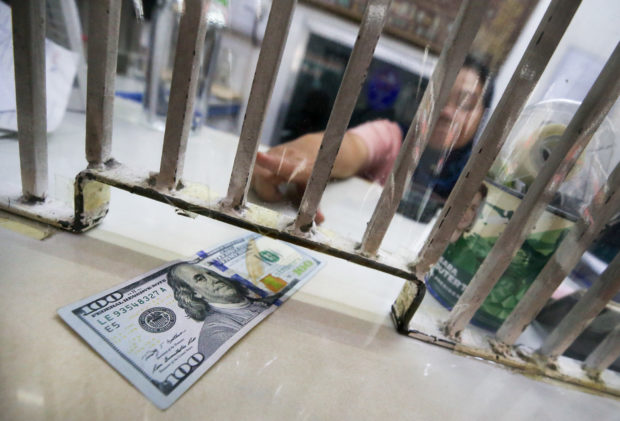Sept forex reserves dropped to $95B

FILE PHOTO: An employee at a money exchange shop on A. Mabini Street in Manila accepts a hundred-dollar bill from a customer so it can be converted into pesos. (Photo by LYN RILLON / Philippine Daily Inquirer)
The Philippines’ gross international reserves (GIR) decreased for the seventh month in a row in September, with $2.4 billion flowing out and $95 billion remaining at the end of the month from $97.4 billion at the end of August.
This happened as the Philippine peso fell to new all-time weakest positions against the US dollar 11 times during the month, twice during four consecutive trading days.
In September, the local currency lost 2.57 to the greenback, starting the month at 56.42:$1 and ending at 58.99:$1.
Even then, the Bangko Sentral ng Pilipinas (BSP) said that preliminary data for September showed that the latest GIR level continued to represent a more than adequate external liquidity buffer.
The BSP’s reserve assets—consisting of foreign investments, gold, foreign currencies, reserve position in the International Monetary Fund, and special drawing rights—are considered adequate if they can finance at least three-months’ worth of the country’s imports of goods and payments of services and primary income.
The GIR reached an all-time high of $110.12 billion in December 2020, and has been decreasing month after month since $107.8 billion last February.
As of end-September, the reserves were still equivalent to 7.6 months’ worth of imports of goods and payments of services and primary income—down from 8.3 months at end-August.
Also, the reserves were about 6.8 times the country’s short-term external debt based on original maturity and 4.1 times based on residual maturity. These numbers diminished compared to end-August levels, pegged at 7.1 and 4.6, respectively.
The BSP said the continued decrease in the GIR was mainly due to the national government’s foreign currency withdrawals from its deposits with the BSP to settle its foreign currency debt obligations.
Credit rating
At the same time, the central bank’s gold holdings continued to decrease in value as the price of the precious metal again went down in the international market.Last month, Fitch Ratings said international reserves held by governments in the Asia-Pacific region were falling and this could undermine the credit rating of some economies, probably including the Philippines.
Fitch Ratings said reserves in the Asia-Pacific region have fallen by an aggregate of $590 billion in the first seven months of 2022.
In February, Fitch Ratings affirmed the Philippine national government’s investment-grade BBB rating, but with a “negative” outlook, reflecting uncertainties in medium-term growth prospects. INQ

